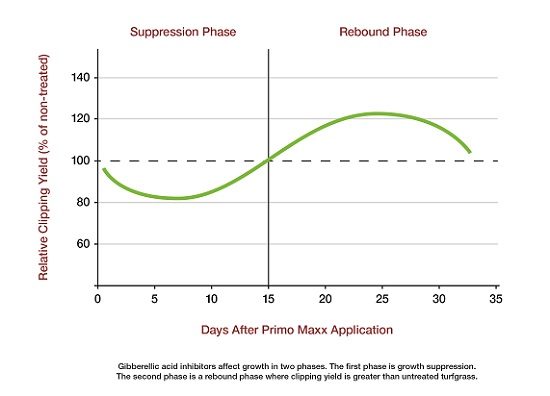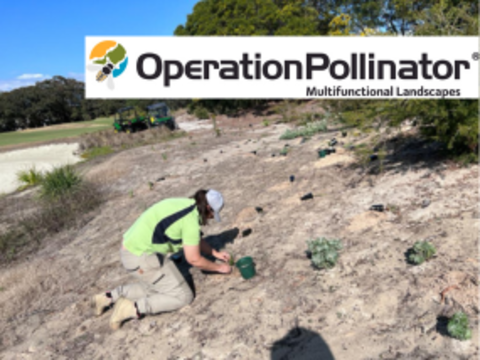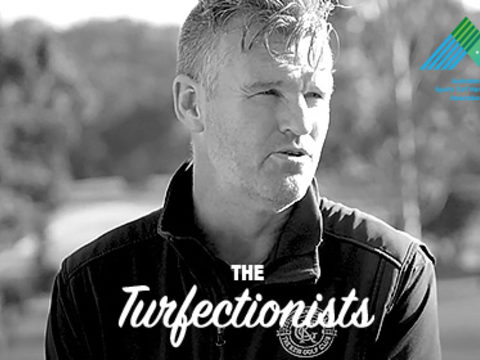Growing Degree Days – a tool for PRIMO application
Plant Growth Regulators (PGRs) have become an integral part of sports turf management by allowing turf grass managers to regulate growth.
PRIMO MAXX, an A class regulator that supresses cell elongation, allows managers to regulate turfgrass growth for 4-6 weeks. In addition, trials show PRIMO MAXX increases the quality of surfaces by improving plant density, enhancing colour and assisting in the development of stronger roots.
Since weather patterns can vary seasonally and from year to year, Growing Degree Days (GDD) can allow turf management professionals to monitor heat accumulation in their area, which translates to the development of the turf. By tracking GDD days, you are able to refine product application timing based on actual weather patterns in your area rather than a pre-determined calendar-based schedule.
Modelling of PGRs has shown there is a suppression phase which is followed by a rebound phase. During the rebound phase clipping yields increase above untreated turf clipping yield.

By using GDD you can make applications at timings that maximise the positive effects of PRIMO.
The equation for GDD uses air temperature (McMaster and Wilhelm, 1997)

Base temperature represents the temperature at which you will typically begin to see plant growth. The base temperature most often used in calculations for turf is 10°C for warm season turf and 0°C for cool season turf.
We cumulatively count GDD until we reach our chosen threshold number of GDDs that you wish to accumulate based on the GDD model you are using. Once we have reached this threshold it is the optimal time for application and the accumulated GDD is reset to 0.
Table 1: Grow degree days accumulated with a base temperature of 0°C.
| Day | Temp: High | Temp: Low | Daily GDD | YTD GDD |
| 1 | 27.2°C | 14.4°C | 20.8 | 20.8 |
| 2 | 22.2°C | 10°C | 16.1 | 36.9 |
| 3 | 22.2°C | 7.2°C | 14.7 | 51.6 |
| 4 | 23.3°C | 9.4°C | 16.35 | 67.95 |
| 5 | 25.6°C | 6.7°C | 16.15 | 84.1 |
Trial work for threshold limits has been conducted mainly on Bent grass greens with both 100 GDD and 200 GDD effective as cumulative thresholds. (Kreuser, 2015). With majority of work to establish thresholds has been undertaken on Bent grass, other grasses that are more sensitive to Trinexapac-ethyl, like hybrid couch greens, will require a different threshold. The 200 GDD is a common starting threshold for introducing the model for PRIMO application. Calibrated thresholds can be achieved through tracking clipping yields.
Research is underway to understand which GDD threshold and base temperature is most appropriate for other grasses including warm season grasses like Couch. Continued development will ensure the most appropriate models are quantified for different turf grass species to ensure under application or over application of PGR is not applied.
When it comes to growing degree day models, it is important to remember that although they serve as useful guides, they don’t replace scouting techniques or your own observations. It is also important to note that for the most accurate GDD data, it’s recommended you utilise an on-site weather station. That said, models such as this do serve as a guide to help you compare month over month and year over year. In support of GDD usage, measuring and monitoring clipping yields is an excellent tool to calibrate your use of GDD to your situation. This can be done with the use of an indicator green.
Grow Degree Days models are an excellent tool for maintaining growth regulation in the most efficient way. It removes the guess work out of choosing the optimal time for re-application. It is simple to operate and can be tracked from readily available weather data from onsite weather station for local weather stations. With continued research and development GDD will continue to allow us to improve our surfaces and managed growth with PRIMO to a whole new level.
For more information on which base temperature and threshold number that best suits your turf management plan, please contact your local Syngenta Territory Manager.
References
KREUSER, W. C. 2015. Effective Use of Plant Growth Regulators on Golf Course Greens. USGA Green Section Record, 53, 1-10.
MCMASTER, G. S. & WILHELM, W. W. 1997. Growing degree-days: one equation, two interpretations. Agricultural and Forest Meteorology, 87, 291-300.
SKORULSKI, J. 2013. Getting a handle on nature's clock: Growing degree days - the secret behind nature's calendar. USGA Green Section record, 51.












